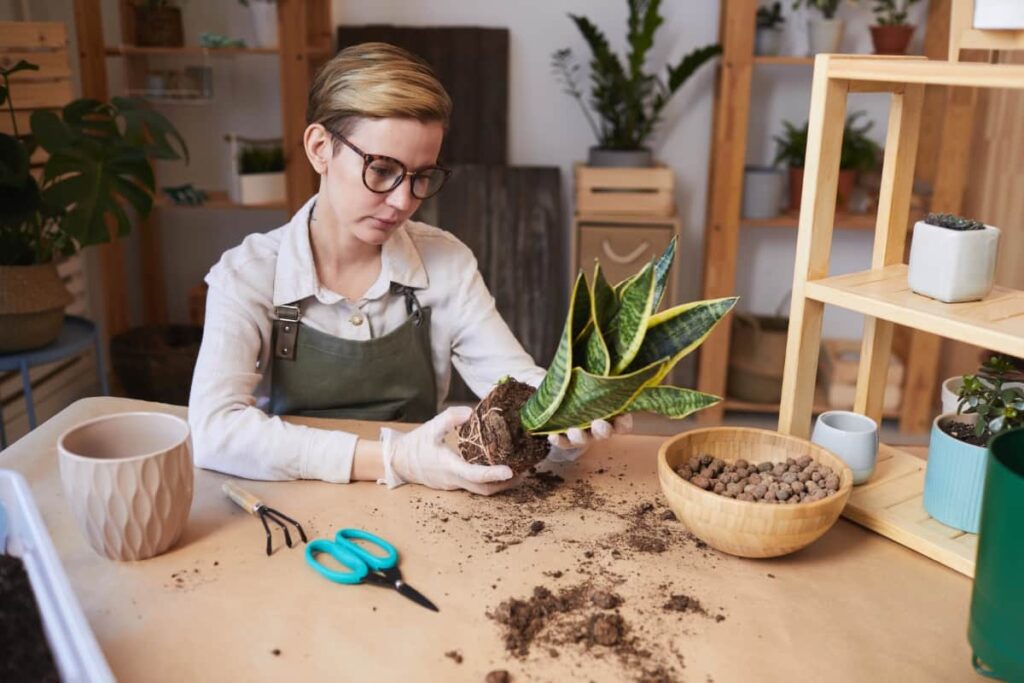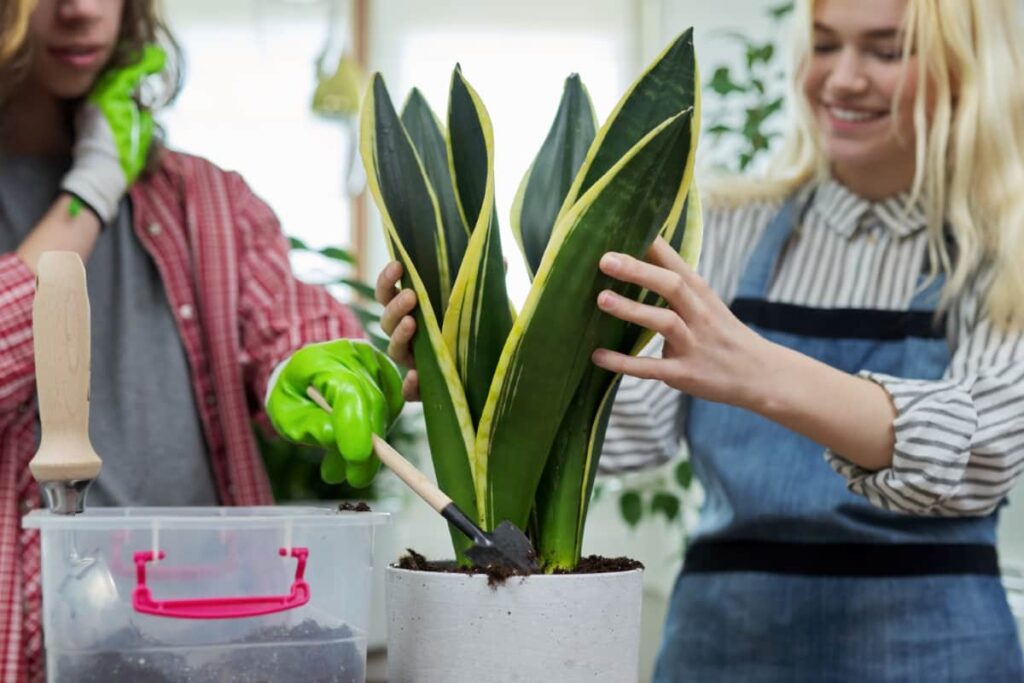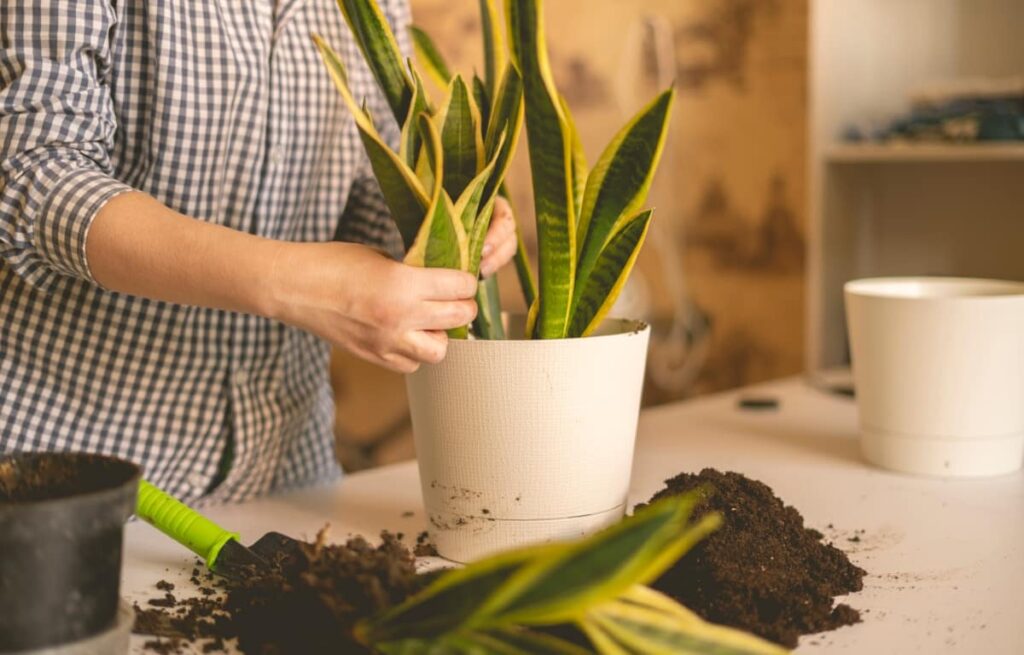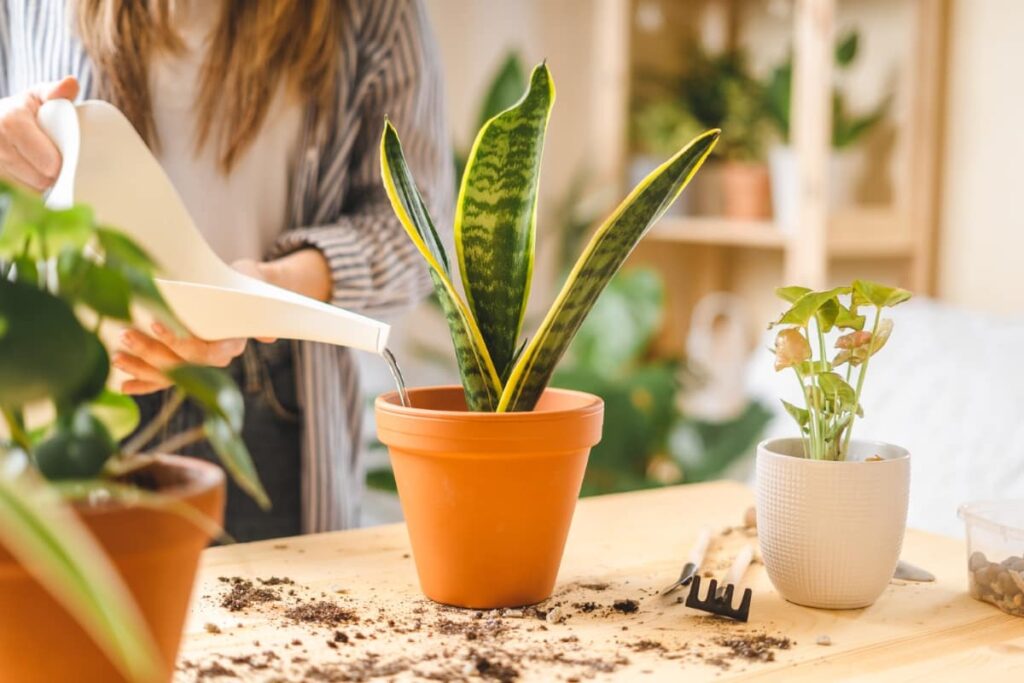The Snake plant, also known as mother-in-law’s tongue or Dracaena trifasciata, is a popular houseplant due to its low maintenance and air-purifying properties. These unique and versatile houseplants are a favorite among many plant enthusiasts. However, like any other plant, it can face some leaf-related issues that may affect its overall health and appearance.

How to Fix Snake Plant Leaf-Related Issues
Yellow Leaves
Yellow leaves on your Snake plant can be a sign of trouble, but don’t worry – there are solutions. Yellowing leaves may indicate overwatering, nutrient deficiencies, or even too much direct sunlight. To fix this issue, start by checking the soil moisture and adjusting your watering routine accordingly. Ensure proper drainage to prevent waterlogged roots.
If yellow leaves persist, consider repotting with fresh soil and trimming any damaged roots. Additionally, feed your Snake plant with a balanced fertilizer to provide essential nutrients it might be lacking. Remember to place your plant in indirect light to avoid sunburn. Monitoring the health of your Snake plant is key – watch for early signs of yellowing leaves and take action promptly.
Soft and Mushy Leaves
Excess moisture in the soil can affect root rot, causing the leaves to become mushy and limp. To remedy this issue, allow the soil to dry out completely between waterings. Remember that your container has proper drainage holes, and remove excess water from the saucer after watering.
If necessary, consider repotting your Snake plant in well-draining soil. Inspect the plant roots for any signs of rot—healthy plant roots should be firm and white. Trim away any mushy or rotten roots before replanting in fresh soil. Remember, prevention is important when it comes to keeping your Snake plant happy and healthy.
Brown Spots or Tips on Leaves
Brown spots or tips are often caused by overwatering, direct sunlight exposure, or nutrient deficiencies. To fix this problem, first assess your plant’s watering schedule—allow the soil to dry out to prevent root rot. Suppose your Snake plant is getting too much sun, and move it to a spot with indirect light. Additionally, make sure your plant is receiving adequate nutrients by fertilizing the plant with a balanced fertilizer during the growing season. You can also trim off any severely damaged leaves to promote new growth and improve the overall appearance of your plant.
Curling and Wrinkled Leaves
Curling leaves are a sign of underwatering or low humidity levels in your plant’s environment. To fix this problem, start by adjusting your watering routine. Make sure you’re giving your Snake plant enough water without overdoing it. Increasing humidity around your Snake plant can also help alleviate curling and wrinkling issues. You can mist the plant leaves or place a tray of water near the plant to enhance moisture in the air.
In case you missed it: Snake Plant Division: How to Divide and Multiply Your Plants

Drooping and Falling Leaves
Drooping and falling leaves can be common issues with Snake plants, but there are natural remedies to help them recover. Overwatering is a possible cause of drooping leaves. Make sure you’re letting the soil dry out between waterings to avoid root rot. On the flip side, underwatering can also lead to droopy leaves, so finding the right balance is key.
To give your Snake plant a little boost, consider repotting it in fresh, well-draining soil. This can help improve air circulation around the roots and prevent waterlogged conditions. Ensure your Snake plant is getting enough light. While they can tolerate low light conditions, they thrive in bright, indirect sunlight. Positioning your plant near a window can make a world of difference in its overall leaf appearance.
Skinny and Stretched Leaves
Snake plants thrive in indirect sunlight, so move yours to a brighter spot. Rotate the plant occasionally so all sides receive equal light exposure to encourage healthier growth. Consider placing plants near a window with sheer curtains for filtered sunlight throughout the day.
Overwatering can also lead to skinny and stretched leaves. Pruning any excessively elongated or leggy leaves can help redirect energy towards new growth. Trim them back at an angle using clean scissors or pruning shears. By addressing these factors promptly, you can help your Snake plant regain its vigor and vitality, resulting in fuller and more robust foliage over time.
Leaves Splitting
Plant leaf splitting can occur due to various reasons, such as overwatering, low humidity levels, or physical damage. To prevent further splitting of the leaves, make sure you are watering your Snake plant appropriately. The soil is well-draining and allow it to dry out between waterings. Additionally, consider increasing the humidity levels around your plant by misting it regularly or placing a humidifier nearby.
Inspect your Snake plant for any pests or disease signs that may be causing the leaves to split. If detected, treat them promptly using natural remedies like neem oil or insecticidal soap. Avoid handling your Snake plant too roughly, as this can also lead to leaf splitting.
Deformed or Misshapen Leaves
Deformities in the leaves may indicate nutrient deficiencies, pest infestations, or improper watering habits. To address this problem naturally and organically, start by examining the overall health of your plant. Ensure that your Snake plant is receiving adequate sunlight but not direct harsh rays that can scorch its leaves.
In case you missed it: Snake Plant Care in Winter: Tips for Keeping Your Plant Healthy

Check the soil moisture levels regularly to avoid overwatering or underwatering, which can lead to leaf deformities. Consider using natural fertilizers like compost tea or diluted seaweed extract to provide essential nutrients for healthy leaf growth. If pests are present, consider using organic pest control methods like neem oil spray to eliminate them without harming your plant.
Stunted Growth
Stunted growth in Snake plants may be caused by various factors such as inadequate light, overwatering, poor soil quality, or lack of nutrients. To help your Snake plant overcome stunted growth, consider adjusting its environment to provide the optimum conditions for healthy development.
Consider fertilizing your Snake plant with a balanced liquid fertilizer diluted at half-strength every 4-6 weeks during its growing season to provide essential nutrients for improved growth. With proper care and attention, you can encourage your Snake plant to overcome stunted growth and thrive beautifully in your home.
Roots are Brown and Mushy
If your Snake plant’s roots are brown and mushy, it is a clear sign of overwatering. To save your Snake plant, you will need to remove it from its pot, trim off any rotten roots, let them dry out for a few days, and repot the plant in fresh, well-draining soil. Remember to adjust your watering schedule to prevent this issue from happening again. Snake plants need to dry out to thrive. By addressing these leaf-related issues with natural and organic remedies, you can help your Snake plant regain its health and beauty.
In case you missed it: How to Propagate Snake Plants: A Step-by-Step Guide

Conclusion
The Snake plant belongs to the Asparagaceae family and this evergreen beauty is characterized by its upright growth habit and broad, sword-shaped foliage. Growing Snake plants can present some leaf-related issues that may leave you scratching your head. Remember, understanding these symptoms is key to restoring your Snake plant’s health.
- Irrigation and Water Management in Pineapple Farming
- Blossom to Harvest: Mastering Flowering and Pollination in Papaya Farming
- Pig Fattening Essentials: From Selection to Sale for Beginners
- Raising Wagyu Cattle: A Complete Guide for Premium Beef Production
- Soil Types and Their Water Holding Capacity
- Optimizing Irrigation Schedules for Coconut Groves for Enhanced Yield
- Espresso Your Garden: Coffee Grounds for Healthier Acid-Loving Plants
- The Best Soil Mix for Snake Plants: How to Mix Your Own Snake Plant Soil
- Green Thumb Success: Expert Tips for Cultivating Greenhouse Beans All Year Round
